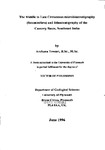The Middle to Late Cretaceous microbiostratigraphy (foraminifera) and lithostratigraphy of the Cauvery Basin, Southeast India
| dc.contributor.author | Tewari, Archana | |
| dc.contributor.other | School of Geography, Earth and Environmental Sciences | en_US |
| dc.date.accessioned | 2013-09-17T09:09:01Z | |
| dc.date.available | 2013-09-17T09:09:01Z | |
| dc.date.issued | 1996 | |
| dc.identifier | NOT AVAILABLE | en_US |
| dc.identifier.uri | http://hdl.handle.net/10026.1/1770 | |
| dc.description.abstract |
The present research is on the Cretaceous microbio- and litho-stratigraphy of the Cauvery Basin, Southeast India. The planktonic and benthonic foraminifera are used to establish microbiostratigraphic zonations for the mid-Cretaceous succession in the Basin; leading to the first proposal of a benthonic foraminiferal zonation scheme. The schemes are primarily defined for regional application. In the absence of a formal lithostratigraphic classification for the Cretaceous succession in the Basin, a revised lithostratigraphy, in line with standard stratigraphic procedure, is proposed. The systematic taxonomy of the foraminifera studied is documented and revised in line with Western standards. The study shows that, in contrast to the standard European forms, the fauna from the Cauvery Basin is composed of more robust individuals. The study also shows some interesting differences in the planktonic foraminifera from the standard Tethyan assemblage. Comparative studies indicate a longer time range for some of the "index" species and more ornamented forms in the Cauvery Basin. The study records two levels, ( I ) in the late Albian and (2) from the late Cenomanian to mid-Turonian, when anoxic conditions developed in the Basin. These anoxic events record major taxonomic changes in the planktonic foraminiferal assemblage. The study shows that the anoxic events had a major affect on the microfaunal community and that the post anoxic microfaunal population was dominated by more robust and heavily ornamented individuals. The planktonic foraminifera are used to identify the mid-Cretaceous sea-level changes in the Basin. The pattern of evolution and expansion of the planktonic foraminifera suggest a continuously rising sea-level in the mid-Cretaceous; with four periods of major transgressions. These levels are, at the late Albian, mid-Cenomanian, late Cenomanian-early Turonian and mid-Turonian. The pattern of sea-level changes in the Cauvery Basin followed , in general, the global sea-level curve, but has been influenced by local factors particularly tectonics. A pilot study demonstrates how palaeontology (including ichnology) in conjunction with sedimentology and stratigraphy is used to apply sequence stratigraphy concepts to the late Turonian-Coniacian succession in the Basin. A comprehensive study of Teredolites-infested fossil wood documents the morphological characters of the wood and its palaeoenvironmental significance. The study shows that there exists a close link between the influx of the fossil wood and sea-level dynamics. | en_US |
| dc.language.iso | en | en_US |
| dc.publisher | University of Plymouth | en_US |
| dc.title | The Middle to Late Cretaceous microbiostratigraphy (foraminifera) and lithostratigraphy of the Cauvery Basin, Southeast India | en_US |
| dc.type | Thesis | |
| plymouth.version | Full version | en_US |
| dc.identifier.doi | http://dx.doi.org/10.24382/4290 | |
| dc.identifier.doi | http://dx.doi.org/10.24382/4290 |
Files in this item
This item appears in the following Collection(s)
-
01 Research Theses Main Collection
Research Theses Main


